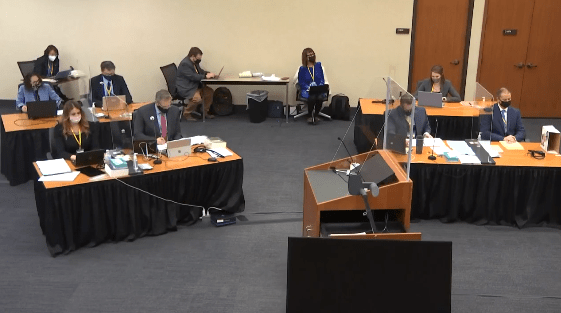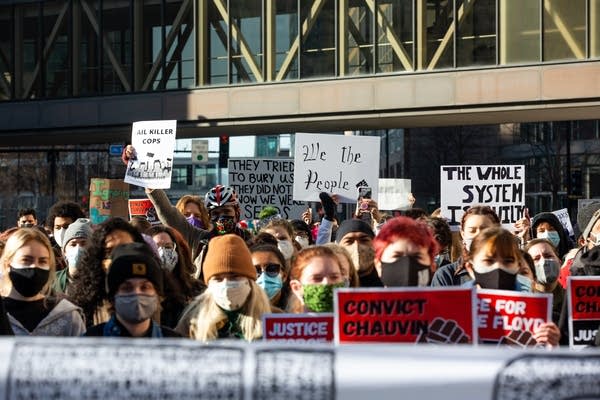Chauvin trial: MPD homicide chief says officers' use of force 'uncalled for'

Go Deeper.
Create an account or log in to save stories.
Like this?
Thanks for liking this story! We have added it to a list of your favorite stories.
MPR News is streaming live coverage of the trial. Some images or material discussed during the trial will be disturbing to many viewers. Watch Friday’s proceedings here. The trial is expected to resume around 9 a.m. Monday.
3 things to know:
Head of MPD homicide division says officers went too far; Chauvin supervisor said Thursday force unneeded after Floyd stopped resisting
Floyd’s girlfriend testified on their struggles with opioid addiction
Case expected to hinge on who or what is responsible for Floyd’s death
Updated 12:01 p.m.
The head of homicide for the Minneapolis Police Department testified Friday that the use of force officers used on George Floyd was “totally unnecessary.”
Lt. Richard Zimmerman told jurors in the trial of former officer Derek Chauvin that after reviewing the body camera footage of police’s fatal encounter with Floyd, he concluded that the officers went too far.
“Pulling him down to the ground, face down, and putting your knee on the neck for that amount of time — it’s just uncalled for,” Zimmerman said. “I saw no reason why the officers felt they were in danger, if that’s what they felt, and that’s what they would have to feel to be able to use that kind of force.”
Turn Up Your Support
MPR News helps you turn down the noise and build shared understanding. Turn up your support for this public resource and keep trusted journalism accessible to all.
He also said he had never been trained to kneel on a suspect's neck because of the danger that it poses. Standard training and policy calls for turning individuals in the prone position on their side, especially once they're handcuffed and no longer pose a threat to police officers, he said.
”If your knee is on a person's neck, that can kill 'em," he told the jury, adding that officers are trained to turn suspects on their side to help them breathe.
Zimmerman is a prosecution witness who responded to the scene of Floyd’s arrest hours after the deadly struggle. He said he reports to every suspicious death in the city.
When he arrived, about two hours after the arrest occurred, he found officers Thomas Lane and J. Alexander Kueng standing at the corner of 38th Street and Chicago Avenue. Once he discovered they were involved, he instructed they be separated and taken to Minneapolis City Hall for questioning.
Prosecutor Matthew Frank asked Zimmerman about his training. He's the most senior officer on the force, and said he still attends use-of-force training every year. Zimmerman explained to the jury the levels of force deemed appropriate depending on the situation an officer encounters.
He testified that once a person is handcuffed, an officer's threat level goes way down. "If they become less combative," Zimmerman said, "the idea is to calm the person down, and if they are not a threat to you at that point you try to help them so that they're not as upset as they may have been in the beginning."
Zimmerman testified that when he got to the scene, he didn’t know the specifics of what happened but told the court that he determined that more officers were needed to secure the area and search for witnesses and building video footage.
Zimmerman said he’d called in a couple of sergeants from the homicide unit, learning later from one of them that Floyd had died, and that the Minnesota Bureau of Criminal Apprehension, the state agency that typically investigates police deadly force incidents, was on the way.
Under cross-examination by defense attorney Eric Nelson, Zimmerman said he is not a patrol officer who frequently interacts with people on the street. He agreed that an officer needs to assess the totality of circumstances when deciding whether to use force. Nelson said the use of force is a "dynamic series of decision making" based on a lot of different information not necessarily captured on a body camera.
But under the prosecution's redirect, Zimmerman emphasized that based on his review of body camera videos, he did not think Chauvin was forced to improvise by putting his knee Floyd for more than nine minutes.
Chauvin faces murder and manslaughter charges in Floyd’s killing last May while in police custody. Bystander video showed Chauvin with his knee pressed against Floyd’s neck for about nine minutes as the man lay handcuffed and pinned to the street, pleading that he couldn’t breathe.
Chauvin supervisor: Use of force went too far
On Thursday, Chauvin’s supervising sergeant that night testified that Chauvin initially told him only that Floyd “suffered a medical emergency” and nothing about keeping his knee pressed against Floyd’s neck.

He said Chauvin acknowledged the use of force on Floyd only after he’d met up with Chauvin at the hospital on the orders of a police lieutenant.
Using a knee is appropriate only until an officer is able to handcuff an individual, Pleoger told jurors. "When Mr. Floyd was no longer offering up any resistance to the officers, they could've ended the restraint.”
The most direct clue so far pointing to Chauvin’s mindset has come from the officer’s video. On Wednesday, prosecutors played footage from Chauvin’s body camera showing a man at the scene criticizing the officer afterward for the way he restrained Floyd.
“That's one person's opinion,” Chauvin responds on the video. “We gotta put force, gotta control this guy because he's a sizable guy. Looks like he's probably on something.”
‘I thought he was dead’
Pleoger’s testimony capped a day in court that included testimony from paramedics who believed Floyd was dead at the scene yet still tried to revive him.
One of them, Derek Smith, checked for a pulse on Floyd when he arrived. Asked what he thought when he couldn't find one on Floyd, he told the court: "In layman's terms, I thought he was dead."
Smith also said he administered an electric shock to Floyd in the ambulance to try to restart his heart, adding: "As a human being, I was trying to give him a second chance at life."
Floyd had gone into Cup Foods that day to buy cigarettes.
A 19-year-old store clerk who suspected Floyd had handed him a fake $20 for the purchase told jurors on Wednesday he first thought about just eating the cost himself but changed his mind and called over his supervisor.
The decision would lead to Floyd’s spiraling, deadly arrest outside the store.

Girlfriend recalls life with Floyd, their addiction struggles
Thursday morning began with Floyd’s girlfriend taking the stand.
Courteney Ross, 45, testified about how she met Floyd, his kindness and their mutual struggle with chronic pain that led to an addiction to opioids.
She choked up as she recalled their first interaction in 2017. She was waiting in the lobby of the Harbor Light Center, a homeless outreach shelter, where the father of her son was living at the time.
“I was pretty upset and started fussing in the corner of the lobby,” she said. That’s when Floyd noticed her and approached. In his “deep southern voice,” Floyd asked her if he could pray with her.
“It was so sweet,” she said, holding back tears.

Ross went on to describe how the two of them shared an addiction to opioids. She said both suffered from chronic pain, which led them to get hooked on prescription medication.
Ross said that at times they got drugs that were not prescribed to them. One or both of them also would stop taking drugs, she said.
Under cross-examination from Nelson, the defense attorney, Ross said Floyd overdosed and went to the hospital in early March 2020.
Ross also said they had gotten drugs from Morries Hall, who was in the car with Floyd on May 25, 2020. On Wednesday, Hall filed a notice to the court that if called to testify, he will invoke his Fifth Amendment protection against self-incrimination.
Ross said Floyd was close to his mother and struggled with grief when she died in May 2018.
Trial basics

Who’s who: A look at the key players in the trial.
Need to know: Key questions about the trial, answered.
What we know about the jurors: The 12 jurors and two alternates picked to review the case include a chemist, a youth volunteer, a cardiac nurse and an IT professional.
Chauvin's lawyer is outnumbered, but has help: No fewer than four attorneys have appeared for the prosecution so far, compared to a single attorney to defend Derek Chauvin.
MPR News on its coverage: Nancy Lebens, the newsroom’s deputy managing editor, answered audience questions about our reporting plans.
George Floyd and his legacy

Remembering George Floyd, the man: Before he became a symbol in the fight for racial justice, friends say Floyd was a “gentle giant” who sought a fresh start.
Making George Floyd Square: Here’s how the site of Floyd’s killing — 38th Street and Chicago Avenue in Minneapolis — is being reshaped.
Rescuing the plywood — and memorializing a movement: Two Black women are leading the effort to preserve the murals painted on storefront boards in the Twin Cities.
Calls for change: Here’s what some Floyd activists tell MPR News about their experiences with race in Minnesota, why they march and what they hope for the future.
Read more

Witnesses relive trauma, guilt over Floyd's death: The first days of testimony at the Chauvin trial have been dominated by the witnesses to his arrest and countless videos that forced them to relive the trauma of it all over again. (The Associated Press)
Video dominates trial in George Floyd's death: A worldwide audience has been shown more than just the widely seen bystander video that set off nationwide protests last year. (The Associated Press)
Minneapolis considered hiring DJ, soccer coach in 'influencer' plan: The city had planned to pay six "trusted messengers” up to $2,000 apiece to share city updates and dispel misinformation during the trial. The plan was scrapped after news coverage and backlash online. (Axios)
Jurors will consider Floyd's death — not the issue of race — in Chauvin trial: The proceedings set to begin with opening statements Monday are unlikely to address those themes directly, even as the case has become a flashpoint for racial justice in America. (Star Tribune)
Televised Chauvin trial due to pandemic yields wide access — and concern: For the first time, the world will be able to see every twist and turn of the case from a Minnesota courtroom, thanks to an unprecedented decision by Judge Peter Cahill.
NPR’s live blog: The latest from the murder trial of Derek Chauvin.
Questions about the Chauvin trial? Ask us
Dear reader,
The trustworthy and factual news you find here at MPR News relies on the generosity of readers like you.
Your donation ensures that our journalism remains available to all, connecting communities and facilitating better conversations for everyone.
Will you make a gift today to help keep this trusted new source accessible to all?




